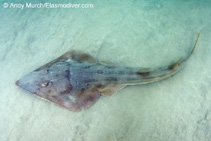| Family: |
Rhinobatidae (Guitarfishes) |
| Max. size: |
119 cm TL (male/unsexed); 170 cm TL (female); max.weight: 9,750.0 g; max.weight: 18 kg; max. reported age: 16 years |
| Environment: |
demersal; brackish; marine; depth range 1 - 91 m |
| Distribution: |
Eastern Pacific: endemic to the eastern Pacific from San Francisco, USA to the Gulf of California, and possibly to Mazatlan, Mexico (Ref. 48844). |
| Diagnosis: |
Broad disc is greater in length than width; a relatively smooth dorsal surface except for a single row of thorns around the eyes and extending along the back and tail; a long, pointed snout with a rounded tip; small, rounded, pebble-like teeth; a first dorsal fin that originates closer to the pelvic fin base than to the caudal fin origin; a thick tail and a moderately large caudal fin without a distinct lower lobe. Tooth count: 102-112/98-117. Spiral valve count: 8-10. |
| Biology: |
Found on sand or mud bottoms of bays, seagrass beds, estuaries, and near rocky reefs. Nomadic and gregarious. Found singly or in aggregations (Ref. 12951). Burrows in sand during the day, feeds on crabs, worms, clams and small fishes at night (Ref. 12951). Ovoviviparous, with 6 to 28 pups in a litter (Ref. 48844). Females mature by 7 years at 87-99 cm TL; males reaches 91-110 cm TL; birth size at 20-24 cm TL (Ref. 114953).
Etymology: The genus comes from the Greek word rhine, meaning shark, and the Latin word batis, meaning ray, in reference to its body form being intermediate between that of a shark and a ray. The species name comes Latin, meaning produced, in reference to its pointed snout (Ref. 48844). |
| IUCN Red List Status: |
Near Threatened (NT); Date assessed: 17 December 2014 Ref. (130435)
|
| Threat to humans: |
harmless |
Source and more info: www.fishbase.org. For personal, classroom, and other internal use only. Not for publication.

